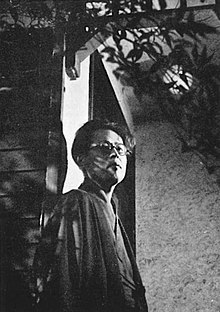Haruo Umezaki (
Haruo Umezaki | |
|---|---|
 Haruo Umezaki in 1950 | |
| Born | February 15, 1915 Fukuoka, Kyushu, Japan |
| Died | July 19, 1965 (aged 50) Tokyo, Japan |
| Occupation | Writer |
| Nationality | Japanese |
| Alma mater | Tokyo Imperial University |
| Period | 1939–1965 |
Biography
editBorn in Fukuoka, Kyushu, Umezaki studied at the 5th High School of Kumamoto University, later at the Tokyo Imperial University where he majored in Japanese literature.[1] He then worked at the same Tokyo University in the Faculty of Education Sciences (kyōiku). In 1944, he was drafted as a crypto specialist for the Imperial Japanese Navy and stationed in Kagoshima Prefecture, Kyushu, an experience which he later dramatised in his famous novella Sakurajima, published in 1946.[2] He came back on this experience in his latest book, Genka (Illusions) published in 1965, the year of his death.
After the war, he worked for the Sunao (
Umezaki died of liver cirrhosis in Tokyo on 19 July 1965.[1]
Selected works
edit- Fūen (
風 宴 ), 1939. - Sakurajima (
桜 島 ), 1946. - Hi no hate (
日 の果 て, End of the Sun), 1947. - Kuroi hana (
黒 い花 , Black Flower), 1950. - Nise no kisetsu (Season of forgery), 1954.
- Boroya no shunjū (ボロ
家 の春秋 , Shanty Life or Occurrences of an Old Dilapidated House), 1954. - Suna dokei (
砂時計 , The Hourglass), 1955. - Tsumujikaze (つむじ
風 ), 1957. - Kurui-dako (
狂 ひ凧 ), 1963. - Genka (
幻 化 , Illusions), 1965.
Awards
edit- 1954: Naoki Prize for Boroya no shunjū
- 1955: Shinchō Award for Suna dokei
- 1963: Ministry of Education, Culture, Sports, Science and Technology Award for Kurui-dako
- 1965: Mainichi Publishing Culture Award for Genka (posthumously)[1]
Adaptations
edit- Films
- 1954: Hi no hate, directed by Satsuo Yamamoto
- 1963: Tsumujikaze, directed by Noboru Nakamura
References
edit- ^ a b c d e "
梅崎 春生 (Haruo Umezaki)". Kotobank (in Japanese). Retrieved 15 August 2021. - ^ "
桜 島 (Sakurajima)". Kotobank (in Japanese). Retrieved 14 August 2021. - ^ Koga, Akira (2004).
小説 の相貌 : 「読 みの共振 運動 論 」の試 み. Kagoshima: Nanpo Shinsha. p. 251. - ^ "
戦後 文学 (Postwar literature)". Kotobank (in Japanese). Retrieved 15 August 2021. - ^ Frédéric, Louis (2002). Japan Encyclopedia. Cambridge and London: The Belknap Press of Harvard University Press. p. 1014. ISBN 978-0-67400770-3.
- ^ a b New Orient. Vol. 7. Czechoslovak Society for Eastern Studies. 1968. p. 26.
Further reading
edit- Kumamoto University Prominent Alumni – Haruo Umezaki : http://ewww.kumamoto-u.ac.jp/dept/fifth/alumni/
- Erik R. Lofgren: Democratizing Illnesses: Umezaki Haruo, Censorship, and Subversion. In: Comparative Literature. 52, no 2, 2000, p. 157–178
- Scott J. Miller: Historical Dictionary of Modern Japanese Literature and Theater. In: Historical Dictionaries of Literature and the arts. Bd. 33, Scarecrow Press, Maryland 2009
- Kyle Grossman, Pomona College: Authors and Soldiers: Reconstructing History in Postwar Japan, 2012. At Claremont.edu.